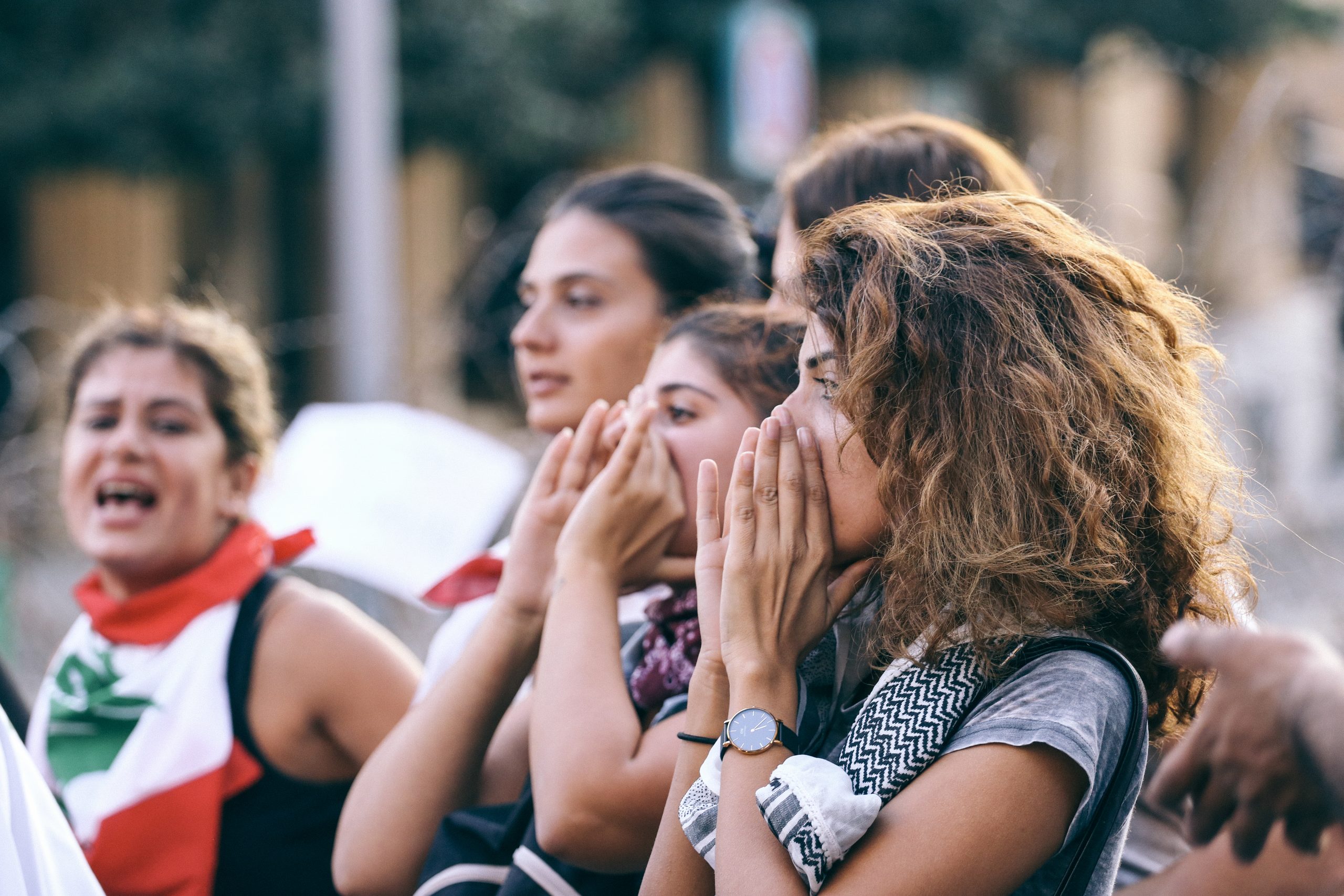Ein Text von: Jonas Baganz
Gelesen von: Daniella Boyd
Was lässt dich aufschreien?
What makes you cry out?
Written by: Jonas Baganz
Read by: Daniella Boyd

Text anhören:
Listen to text:
Eine Gruppe junger Frauen*, ihre Hände bilden die Resonanzkammern der Parolen. Sie verstärken die Rufe und unterstreichen die Vehemenz ihrer Forderungen. Im verschwommenen Hintergrund ist eine weitere Frau zu sehen, eine libanesische Fahne ist um Hals und Oberkörper geschlungen. Die Nationalflagge scheint gesellschaftliche Zugehörigkeit und ihren Anspruch auf Repräsentation zu signalisieren. Der Blick ist unbestimmt in die Kamera gerichtet, das Gesicht ist im Moment des Schreis gebannt.
Lilian Mauthofer dokumentiert in dieser atmosphärischen Aufnahme die Essenz der Proteste auf fast metaphorische Weise. Das Rufen der Personengruppe ist per se der Bruch mit einem aufgezwungenen Schweigen – das Schreien das Gegenteil des stummen Erduldens. Die spontan anmutende Fotografie zeigt die jungen Frauen* während des Straßenprotestes. Sie ziehen ihre Stärke aus der gemeinschaftlichen Handlung und nicht zuletzt aus dem gemeinsamen Rufen einender Parolen. Dem synchronen Schreien.
In der Kunstgeschichte sprechen wir von Ikonographie, wenn wir die Geschichte bestimmter Motive sowie ihre Veränderungen im Laufe der Zeit beobachten und die Gründe für diese Prozesse hinterfragen. Das Schreien oder der Schrei hat eine vielfältige Ikonographie. Diese erklärt in Ansätzen, warum die betrachtete Fotografie so wirkungsvoll die Situation der Protestierenden einfängt.
Der Kunsthistoriker Andreas Beitin bezeichnet in seiner Doktorarbeit zum Phänomen des Schreis in der Kunst des 20. Jahrhunderts diesen „als evidente[n] Ausdruck einer extremen psychischen Verfassung, der als die intensivste menschliche Kommunikationsform das Gesichtsfeld radikal verändert [und] zugleich eine Seelenschau“¹ darstellt. Dem Autor zufolge gebe es verschiedene Darstellungsebenen des Motivs, häufig gehe es um ein Wechselspiel der Macht und damit um Unterdrückung und Befreiung. Gerade der Themenkomplex aus Sexualität und Gewalt spiele eine wichtige Rolle in der Ikonografie des Schreis im 20. Jahrhundert. So werde die Unterdrückung der Frau und das zur Wehrsetzen zu einem immer prominenteren Motiv.² Hier zeigt sich ein enger Zusammenhang zu den im Rahmen dieser Ausstellung gezeigten Fotografien, die einen konzentrierten Blick auf die feministischen Aspekte der Thawra werfen.
Der Schrei durchwandere, so Beitin weiter, in seinen Darstellungsformen verschiedene Bedeutungsänderungen: Anfang des 20. Jahrhunderts zeige er vor allem Not und Existenzängste und verändere sich zunehmend in Richtung eines symbolischen und experimentellen Motives. Der Schrei werde vor allem im Kontext politischer Umbrüche oder kriegerischer Auseinandersetzungen als „Anklage sozialer Missstände sowie allgemeiner menschlicher Not“³ verwendet, um Sympathie und Empathie für das Leid anderer zu wecken.
Der kurze und zweifelsfrei unvollständige, theoretische Exkurs bietet eine Lesart der Fotografie an. Allerdings beschreibt Andreas Beitin in seiner Arbeit den Schrei im Kontext der Malerei. Die von ihm besprochenen Werke sind inszenierte künstlerische Äußerungen einer spezifischen Zeit und sind als politische und gesellschaftliche Reaktionen zu verstehen. Die Fotografie von Lilian Mauthofer wiederum ist spontan entstanden und zeigt einen realen Ausschnitt aus dem Leben. Auch wenn die Motivauswahl, die Unschärfe und der Bildausschnitt ebenfalls Formen der Inszenierung sind, funktionieren sie unmittelbarer und intuitiver als in der Malerei. Der Aspekt der Intuition scheint im Zusammenhang mit der Deutung des Bildes entscheidend. Das Herausgreifen der Personengruppe aus dem Zusammenhang der Demonstration und die isolierte Darstellung ihrer Protestschreie, zeugt von den Wirkungsebenen, die dem Motiv des Schreis eingeschrieben sind. Wir als Betrachter:innen und Lilian Mauthofer als Künstlerin wissen um die gesellschaftliche Bedeutung des Schreis, wir lesen ihn als Empowerment, als Klage, als Ausdruck des Protestes und der Gemeinschaft. Auch deshalb ist diese Fotografie so wirkmächtig, sie aktiviert ein in unseren Köpfen eingeschriebenes ikonografisches Wissen um das Motiv des Schreis.
¹ Andreas Beitin: Der Schrei. Kunst- und Kulturgeschichte eines Schlüsselmotivs in der deutschen Malerei und Grafik des 20. Jahrhunderts. Diss. Münster 2004. 12.
² vgl. ebd., 179 f.
³ ebd., 217.
A group of young women*, their hands forming the resonance chambers of the slogans. They are intensifying the shouts and underlining the vehemence of their demands. In the blurred background, another woman can be seen, a Lebanese flag wrapped around her neck and upper body. The national flag seems to signal social affiliation and their claim to representation. The gaze is directed indefinitely into the camera, the face is captured in the moment of screaming.
In this atmospheric shot, Lilian Mauthofer documents the essence of the protests in an almost metaphorical way. The shouting of the group of people is the break with an imposed silence – the screaming the opposite of the mute endurance. The spontaneous-looking photograph shows the young women* during the street protest. They draw their strength from the collective action and last but not least, from the common shouting of unifying slogans. The synchronous shouting.
In art history, we speak of iconography when we observe the history of certain motifs and their changes over time. and we question the reasons for these processes. The scream or cry has a diverse iconography. This explains, to some extent, why the photograph under consideration captures the situation of the protesters so effectively.
In his doctoral thesis on the phenomenon of screaming in 20th century art, the art historian Andreas Beitin describes it as „an evident expression of an extreme psychological condition, which, as the most intensive form of human communication, radically changes the visual field, while at the same time, it represents a vision of the soul“.¹ According to the author, there are different levels of representation of the motif; often it is about an interplay of power and thus about oppression and liberation. The complexity of themes of sexuality and violence plays an important role in the iconography of the scream in the 20th century. Thus, the oppression of women and the fight against it became an increasingly prominent motif.² This is closely related to the photographs shown in this exhibition, which take a concentrated look at the feminist aspects of the Thawra.
According to Beitin, the scream goes through various changes of meaning in its forms of representation: At the beginning of the 20th century, it showed above all need and existential fears, and increasingly changed in the direction of a symbolic and experimental motif. In the context of political upheavals or armed conflicts, the cry is used as an „accusation of social grievances and general human misery“³ to arouse sympathy and empathy for the suffering of others.
The short and undoubtedly incomplete theoretical digression offers a reading of photography. In his work, however, Andreas Beitin describes the cry in the context of painting. The works he discusses are staged artistic expressions of a specific time and should be understood as political and social reactions. The photography of Lilian Mauthofer, on the other hand, is spontaneous and shows a real section of life. Even though the choice of motif, the blurring and the cropping of the image are also forms of staging, they function more directly and intuitively than in painting. The aspect of intuition seems to be decisive in connection with the interpretation of the picture. The removal of the group of people from the context of the demonstration and the isolated depiction of their cries of protest testifies to the levels of action inscribed in the motif of the scream. As viewers and Lilian Mauthofer as an artist, we are aware of the social significance of the scream, we read it as empowerment, as a lament, as an expression of protest and community. This is one of the reasons why this photograph is so powerful – it activates an iconographic knowledge of the motif of the scream inscribed in our heads.
¹ Andreas Beitin: Der Schrei. Kunst- und Kulturgeschichte eines Schlüsselmotivs in der deutschen Malerei und Grafik des 20. Jahrhunderts. Diss. Münster 2004. 12.
² cf. ibid., 179 f.
³ ibid., 217.
